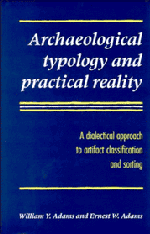 Archaeological Typology and Practical Reality
Archaeological Typology and Practical Reality Book contents
- Frontmatter
- Contents
- List of figures
- List of tables
- The archaeologist's preface
- The philosopher's preface
- PART I Introductory
- PART II The nature of types and typologies
- PART III Typology in action: the Medieval Nubian Pottery Typology
- PART IV Pragmatics of archaeological typology
- 13 The starting point: purpose
- 14 The determinants of types: variables and attributes
- 15 The making of types: formulation, designation and description
- 16 The use of types: typing and sorting
- 17 The ordering of types: taxonomy and seriation
- 18 Variation and variability in archaeological classifications
- 19 The bottom line: practicality
- 20 Principles of practical typology
- 21 Information-theoretic formulations
- PART V Classification, explanation, and theory
- Appendices
- References
- Index
18 - Variation and variability in archaeological classifications
Published online by Cambridge University Press: 23 November 2009
- Frontmatter
- Contents
- List of figures
- List of tables
- The archaeologist's preface
- The philosopher's preface
- PART I Introductory
- PART II The nature of types and typologies
- PART III Typology in action: the Medieval Nubian Pottery Typology
- PART IV Pragmatics of archaeological typology
- 13 The starting point: purpose
- 14 The determinants of types: variables and attributes
- 15 The making of types: formulation, designation and description
- 16 The use of types: typing and sorting
- 17 The ordering of types: taxonomy and seriation
- 18 Variation and variability in archaeological classifications
- 19 The bottom line: practicality
- 20 Principles of practical typology
- 21 Information-theoretic formulations
- PART V Classification, explanation, and theory
- Appendices
- References
- Index
Summary
In previous chapters we have considered a number of factors, theoretical as well as practical, that influence the development of classificatory systems. We are now ready to discuss the different kinds of classifications, typologies, and taxonomies that archaeologists actually make and use, and the reasons why they differ one from another. We will begin by re-emphasizing certain basic structural distinctions that affect many different kinds of classifications. We will then go on to consider some specific kinds of classifications that archaeologists make for different purposes. Finally we will discuss some additional, practical considerations that are unrelated to purpose, but that may result in variation from one classification to another.
Basic structural distinctions
Classification and typology. We indicated in Chapter 4 that, according to our usage, a classification is any contrasting set of categories into which a specific body of material may be subdivided, or partitioned. A typology is a particular kind of classification; one designed for the sorting of entities into categories that are absolutely mutually exclusive. The practical importance of this distinction will appear when we discuss the differences between artifact classifications, which are nearly always typologies, and “culture” classifications, which are not.
Typology and taxonomy. A basic typology has only one level of abstraction or generalization; all of its member types are considered to be equivalent in this respect (see Chapter 7).
- Type
- Chapter
- Information
- Archaeological Typology and Practical RealityA Dialectical Approach to Artifact Classification and Sorting, pp. 214 - 232Publisher: Cambridge University PressPrint publication year: 1991


